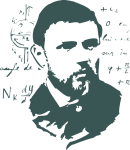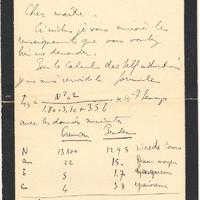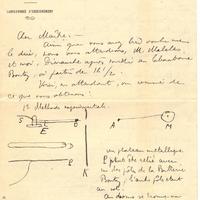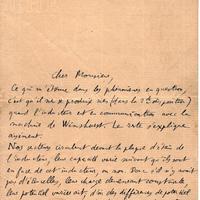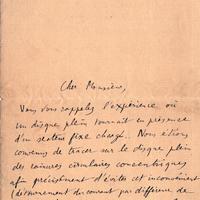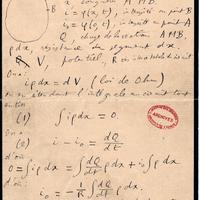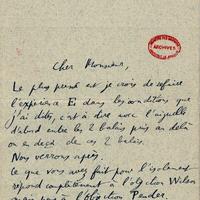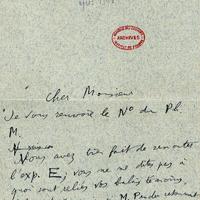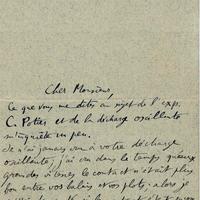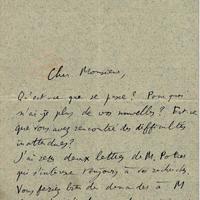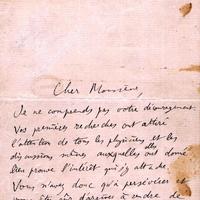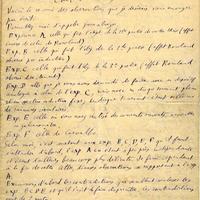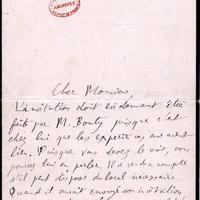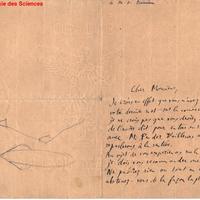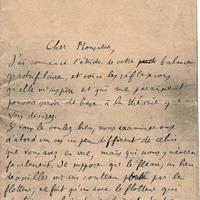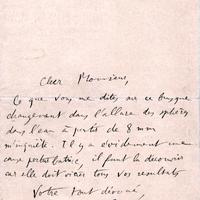Victor Crémieu (1872–1935) was born in Avignon, and obtained the Ph.D. in physics at the Sorbonne under Gabriel Lippmann’s direction in 1901. As a result of his experimental investigations of rotating electrified disks, Crémieu was led at first to deny the existence of a magnetic effect of convected electricity, predicted by Faraday and Maxwell, and first detected in 1876 by Henry Rowland. Crémieu later recognized the reality of Rowland’s effect, attributing his null results to an unsuspected masking phenomenon. He went on to perform delicate, but ultimately inconclusive experiments on gravitational attraction, and in later life found employment in private industry.11Annuaire de la Société française de physique, 1912, 11; Pierre Crémieu, p.c., 25.05.1997.
Much of the Crémieu-Poincaré correspondence concerns Crémieu’s attempts between 1901 and 1903 to detect a magnetic action of electrical convection. Rowland’s effect, cast in the framework of Maxwell’s theory originally by J.J. Thomson in 1881, and with greater rigor by Oliver Heaviside in 1889, assumed significance for electrodynamics only with the rise of atomistic theories, accelerated by the discovery of the electron in 1897. The Maxwellian view of electric current as decay of electric polarization gave way, with the rise of atomistic electrodynamics in the 1890s, to a conception of charged particles moving in empty space, of which Lorentz’s theory was the leading example.22On the history of electrodynamics in this period, see Whittaker (1951, 305), Buchwald (1985), Jungnickel & McCormmach (1986, 231), Darrigol (2000, chap. 8). It was at this time that Crémieu began his doctoral research at the Sorbonne. On the advice of his supervisor Gabriel Lippmann, Crémieu took up the study of electrical convection, but was unable to reproduce Rowland’s celebrated result, and concluded that a convected current had no magnetic effect, contrary to the previsions of Lorentz’s electron theory. In fact, Crémieu claimed that he had realized an open conduction current, of the sort ruled out by Maxwell’s theory of the electromagnetic field, but allowed in the alternative theories of Wilhelm Weber, Franz Neumann and Hermann von Helmholtz.
Poincaré, who was by this time the leading French authority on electrodynamics, took an interest in Crémieu’s experiments.33, Archives nationales; Poincaré 1901a; Petiau 1954, 391–420. Only the first six sections of the 1901 article were reedited in Science et hypothèse (Poincaré 1902a), omitting the discussion of Crémieu’s experiments. Maxwell’s theory had found strong confirmation in Heinrich Hertz’s famous experiments with electromagnetic waves, and Poincaré had played an important part in this process by contributing a theory of the resonator. Several electrodynamicists, including Hertz, had attempted to apply Maxwell’s theory to matter in motion. Hertz’s theory of the electrodynamics of moving bodies, however, assumed in effect that the carrier of electromagnetic effects — the ether — was completely convected by matter in motion. Hertz (1890, 398) admitted the implausibility of his constraints, a limitation which partially rectified by a different, and more successful theory elaborated by Lorentz. Here it was assumed that a dielectric in motion carried with it not the ether, but electrons. Lorentz’s theory, like Hertz’s, could account for the experimental results of both Röntgen and Rowland. Despite its status as a crucial test of the leading candidate for a final theory of physics, in the laboratory, Rowland’s effect had been established qualitatively at best.44For the view of Rowland’s effect as a crucial test of Lorentz’s theory, see the latter’s 1907 lecture “The experimental foundations of the theory of electricity” (Zeeman & Fokker 1935, 125–151), and Eichenwald (1908, 83).
Before Crémieu took up the problem, the magnetic effect of a charged particle in motion was borne out by a series of observations: spark discharge showed such an effect (assuming material particles from the electrode carry charge to the anode), as did ionic currents in electrolysis (assuming ions to be charge carriers), and cathode rays (assumed to be composed of charged particles). Rowland’s experiment required no special assumptions concerning the charge carrier, and assumed a particular epistemological status. For Maxwellians, the Rowland effect was not a major concern, although there were differences on how to calculate the self-energy of a charged sphere in motion (Buchwald 1985, 273). What Rowland’s experiment indicated to the Cambridge theorist Joseph Larmor, however, was the discrete nature of electrical current, made up of electric charges in motion (Whittaker 1951, 365). Larmor convinced himself — and many others — that Rowland’s result could not be accounted for by Maxwell’s theory, and required a theory of the electron, such as he proposed.55Larmor’s view ignored Hertz’s demonstration that the existence of displacement currents on a rotating, uniformly electrified disk was implied by Maxwell’s theory; on this and other errors in Larmor’s criticism of Maxwell’s theory, see Darrigol (2000, 342). The discovery of the electron and the Zeeman effect provided further arguments for an atomistic view of electricity. In the face of evidence amassed in favor of a magnetic effect of convected charge, most physicists naturally assumed there to be errors in Crémieu’s laboratory setup, his physical reasoning, or both.
This high degree of confidence in both the reality of the effect and its necessity from a Maxwellian standpoint meant that Crémieu’s work was unlikely to be given a hearing — let alone an objective evaluation — without the assistance of a leading scientist. Poincaré assumed this role with relish, observing wryly that many of Crémieu’s skeptics were English. Young Crémieu’s work was to be judged on its merits alone, in other words (Poincaré 1901a, 410). Prominent among the skeptics was Joseph Larmor, Britain’s leading expert on electron theory, who prompted H.A. Wilson to write an article explaining Crémieu’s result as the consequence of a basic flaw in his apparatus design.66Indorato & Masotto 1989, 130. On Larmor’s view of Rowland’s experiment, see Darrigol (2000, 342). Others, like Augusto Righi and Tullio Levi-Civita, similarly expected a null effect on Maxwellian grounds, based on the design of Crémieu’s apparatus.77See the correspondence with Levi-Civita (Levi-Civita à Poincaré - 1901-12-11 ). The superior design of Crémieu’s experiment, however, figures strongly in Poincaré’s early support of his results (H. Poincaré: Rapport sur la thèse de Crémieu), which render the existence of Rowland’s effect “very doubtful”.
Poincaré’s stormy relation with Maxwell’s theory begins with his preface to the textbook Électricité et optique, where he takes a celebrated swipe (Poincaré 1890, v) at the precision and logic of Maxwell’s Treatise on Electricity and Magnetism. In correspondence with Hertz, however, he aligns himself squarely on the side of Maxwell’s ideas (Poincaré à Hertz - 1890-09-11 ). Leading physicists, including G.F. FitzGerald and Paul Drude, contest details of Poincaré’s interpretation of Maxwell, and it seems clear that Poincaré is led astray on occasion by his flawed understanding of the basic Maxwellian notions of charge and current.88FitzGerald 1892; Drude 1897, XXI. Even so, his Sorbonne lectures of 1888 and 1890 are instrumental to the diffusion of Maxwell’s ideas, and provide a convincing demonstration of the power of British abstract dynamics.99Darrigol 1993, 223. On the French reception of Maxwell’s theory, including Poincaré’s role, see Coelho Abrantès (1985) and Atten (1992).
When the second edition of these lectures appears in 1901, with new material on the electron theories of Lorentz and Larmor, Poincaré warns readers that these theoretical innovations are menaced by Crémieu’s results. Nevertheless, when the existence of Maxwell’s displacement currents — denied by Crémieu — is attacked in the pages of a technical journal he co-edits, Poincaré (1901b) takes it upon himself to respond in Maxwell’s stead.
For Crémieu, the international attention to his work was surely flattering, but the pressure to respond to sharp, and often dismissive criticism from Wilson and others took its toll, as both he and Poincaré began to question the certainty of some of his results (Poincaré à Crémieu - 1901-08 ).
Crémieu’s results are subject to close scrutiny in France. At the Sorbonne, Lippmann and Bouty find them to be sound, and at the Collège de France, Marcel Brillouin (1904, 265) announces that they represent a substantial challenge to Maxwell’s theory. Yet Poincaré’s Sorbonne colleague Henri Pellat is dubious of Crémieu’s results, and Alfred Potier, Poincaré’s former instructor at the École polytechnique, can see no fundamental contradiction between Crémieu’s results and Maxwell’s theory. Poincaré answers Potier in an exchange published in part by the technical journal L’Éclairage électrique (Poincaré 1902), and fully transcribed in (Alfred Potier). He also seeks — without success — to convince the reputed experimenter René Blondlot to reproduce Crémieu’s experiments (Blondlot à Poincaré - 1901-11-10).
The principal challenge to Poincaré and Crémieu comes not from theorists, but from a young American experimenter, Harold Pender. At Johns Hopkins University, on the instigation of the bedridden Rowland, Pender carries out a series of experiments that confirm Rowland’s earlier results, and set a new standard of precision for measurements of charge convection on a rotating disk. In addition to providing quantitative evidence of Rowland’s effect, Pender points out certain difficulties in Crémieu’s setup that had been overlooked by Poincaré. To settle the matter, Poincaré, after carefully seeking — and obtaining — William Thomson’s endorsement, makes an extraordinary move: he calls for a side-by-side repetition of Crémieu’s and Pender’s experiments.1010Two years earlier, Poincaré (1902b, 218) had arranged for an exchange of astronomers between Paris and Greenwich, in order to resolve discordant measurements of the difference in longitude between the two observatories. The Institut de France underwrites the expenses incurred by Bouty’s laboratory in hosting the face-off, probably on Poincaré’s suggestion, while the Carnegie Institution of Washington provides the funds for Pender’s participation. When the American money was all spent, Poincaré asked his Hopkins colleague Joseph Ames (Poincaré à Ames - 1903-03-28) to seek an extension.1111The Carnegie Institution of Washington underwrote all of Pender’s expenses, in the amount of $662.57. According to Pender’s unpublished report to his sponsor, the Institut de France contributed 7000 francs to defray costs incurred by Bouty’s laboratory in hosting the experiments (Pender to D. C. Gilman, 09.05.1903, Harold Pender file, Archives of the Carnegie Institution of Washington).
At the issue of a three-month collaboration in Bouty’s laboratory in 1903, Crémieu and Pender qualitatively confirm Rowland’s effect on both sides,1212Pender attributed his failure to obtain a quantitative reproduction of his earlier results to magnetic disturbances in Bouty’s Sorbonne laboratory (Pender to D.C. Gilman, 09.05.1903, op. cit.). and agree that the effect had been masked by a dielectric coating applied to the disks and armatures of Crémieu’s apparatus. Using Pender’s equipment, the two physicists demonstrated Rowland’s effect for the French Physics Society, on April 17 1903, marking the end of the controversy, as far as Pender is concerned (Crémieu & Pender 1903, 956).
On the following day, however, another Sorbonne experimentalist challenged the explanation offered for Crémieu’s null results, denying that a dielectric coating could reduce the magnetic effect of convected charge (Vasilesco-Karpen, 1903, 168–169). Taking up the new challenge, this time with a colleague, Crémieu seeks to establish what one physicist calls the “Crémieu-Pender effect,” publishing two notes on this investigation in the Comptes rendus, both of which are presented by Poincaré.1313Sutherland 1904; Crémieu & Malclès 1904a, 1904b, presented 11.11.1904 and 12.12.1904, respectively.
However, the latter effect resists all efforts by others at reproduction, and is summarily dismissed as spurious by A. Eichenwald, who assigns to experimental error Crémieu’s repeated null findings for the Rowland effect.1414Eichenwald (1908, 86) eliminated the hypothesis of a masking effect generated by the dielectric, and guessed that Crémieu’s null results were due to inadequate isolation and point discharge. Along with Eichenwald, F. Himstedt (1904) manages to reproduce Pender’s measurements quantitatively, and establishes the Rowland effect on firm ground. Since few leading physicists had entertained doubts over the reality of the Rowland effect, the upshot of the Crémieu-Pender meeting was a striking confirmation of the excellence of Rowland’s school of experimental physics, at the expense of Poincaré and, more generally, of French expertise in precision electrical measurement.1515On the damage to French scientific prestige, see M.-J. Nye (1986, 71). The Pender-Crémieu outcome heralded the greater blow dealt by R.W. Wood (another Hopkins physicist), in his much-publicized debunking of René Blondlot’s N rays. On Rowland’s school, see Sweetnam (2000).
Poincaré acknowledges the outcome by silently rewriting the passage of La science et l’hypothèse concerning Crémieu’s experiments. According to his mature view of the episode, Crémieu’s experiments shook the foundations of modern electrodynamics:
L’édifice de l’électrodynamique semblait, au moins dans ses grandes lignes, définitivement construit ; cette quiétude a été récemment troublée par les expériences de M. Crémieu qui, un instant, ont semblé contredire le résultat autrefois obtenu par Rowland. Les recherches nouvelles ne les ont pas confirmées, et la théorie de Lorentz a subi victorieusement l’épreuve.1616Poincaré 1906, 281. The cited passage is struck from later editions of Science et hypothèse. Poincaré’s first published view of Crémieu’s experiments (1901a) was published in modified form in chapter 13 of La science et l’hypothèse, in several editions (1902, 1906, 1907); excerpts of his correspondence with Alfred Potier on this topic appear in Poincaré (1902). Poincaré’s mature view of the Crémieu episode (Poincaré 1908, 387) emphasizes that Rowland’s effect is required by the first law of thermodynamics.
Later readings of Rowland’s experiment and the Crémieu-Pender experiments include J. Sivadjian (1953) and H. Arzeliès (1959, 92–98); both references include extensive bibliographies. On the Crémieu-Pender controversy see J.D. Miller (1972), and for discussions of Poincaré’s role see A.I. Miller (1973), O. Darrigol (1995), and the detailed study by L. Indorato & G. Masotto (1989). The latter reference provides a transcription of several of the letters exchanged between Poincaré, Crémieu, and W. Thomson.
The Poincaré-Crémieu correspondence is not limited to the investigation of Rowland’s effect. Having invested heavily in his bid to overturn Maxwell’s theory — a doctoral thesis and some 21 papers were now rubbish — Crémieu was humiliated by the outcome. He was not totally defeated, however, as he had another line of research in progress, one with the potential to repair the damage done to his reputation by the face-off with Pender. This second project began in 1902 with financial support from the Institut de France, and was designed to overturn Newton’s law of gravitational attraction. Several physicists, including H.A. Lorentz, J.H. Poynting, and Poincaré had wondered if gravitation, like electromagnetism, is not a field-theoretical phenomenon, the action of which propagates in the manner of a wave; if this were so, then the gravitational force might depend in some way upon the characteristics of the matter through which it propagates.1717On gravitational absorption and field theories of gravitation ca. 1900, see Zenneck (1903) and Roseveare (1982). On Vito Volterra’s attempt to characterize the energy of gravitation, see (Volterra à Poincaré - 1900-01-23). There was also the possibility of a small variation of the inverse-square law, which seemed likely to Poincaré (1900, 1165) in the form of additional terms, whose existence would be revealed at short range.1818A short-range effect of this sort made headlines in the late 1980s, as Franklin (1993) observes.
Crémieu’s experiments were meant to test the dependence of gravitational attraction on the substance separating two test bodies. The experiments were of two types: in the first set, he measured the displacement of oil droplets in liquid, while in the second set, he relied on a custom-built torsion balance to measure the attraction of bodies in air and in water. Both sets of experiments produced results at odds with the Newtonian prediction, yet once again, Crémieu convinced himself that they were artifacts of his apparatus.1919Crémieu 1905a, 1905b, 1905d, 1906, 1910. The curious result of the first set of experiments — the mutual attraction of oil droplets in liquid — was explained away by Poincaré as the consequence of the liquid’s inhomogeneity (§ Poincaré à Crémieu - 1902-07-23).
Poincaré commented on various aspects of the oil-drop experiments, but warned Crémieu not to publish anything, or at least to forgo the interpretation of his experimental results, until such time as the charge convection controversy was resolved, lest he destroy his credibility. Crémieu followed this advice, while pursuing his investigations. In 1904 he worked on a Cavendish experiment based on a novel torsion balance, for which Poincaré provided the theory. Poincaré also communicated to the Paris Academy of Science several of the notes Crémieu submitted in connection with the torsion balance. Although Poincaré did not comment publicly on these experiments, he covered the subject of gravitational absorption in the course of his 1906–1907 lectures on the limits of Newton’s law (Poincaré 1953, 186–190). As for Crémieu, although he acknowledged Poincaré’s guidance in the Cavendish experiments, he seems to have relied more on the aid and counsel of Edmond Bouty.2020For Crémieu’s acknowledgments see Crémieu (1905c, 499). There is no record of contacts between Poincaré and Crémieu from 1905 until Poincaré’s death in 1912, at which time Crémieu urged Paul Langevin to become Poincaré’s intellectual successor.2121Crémieu to Langevin, ca. 07.1912, Langevin Archives 83.
References
- Milieux conducteurs ou polarisables en mouvement. Gauthier-Villars, Paris.
- Les théories électriques en France (1870–1900) : la contribution des mathématiciens, des physiciens et des ingénieurs à la construction de la théorie de Maxwell. Ph.D. Thesis, École des hautes études en sciences sociales, Paris.
- Propagation de l’électricité : histoire et théorie. Hermann, Paris. External Links: Link.
- From Maxwell to Microphysics. University of Chicago Press, Chicago.
- La réception en France des théories de Maxwell concernant l’électricité et le magnétisme. Ph.D. Thesis, Université Paris 1, Paris.
- Recherches sur les diélectriques solides. Comptes rendus hebdomadaires de l’Académie des sciences de Paris 139, pp. 790–792. External Links: Link.
- Recherches sur les diélectriques solides. Comptes rendus hebdomadaires de l’Académie des sciences de Paris 139, pp. 969–972. External Links: Link.
- On the magnetic effect of electric convection. Philosophical Magazine 6, pp. 442–464. External Links: Link.
- Attraction observée entre gouttes liquides suspendues dans un liquide de même densité. Comptes rendus hebdomadaires de l’Académie des sciences de Paris 140, pp. 80–83. External Links: Link.
- Dispositif auto-amortisseur applicable aux mouvements pendulaire et oscillatoire. Comptes rendus hebdomadaires de l’Académie des sciences de Paris 140, pp. 1029–1031. External Links: Link.
- Recherches expérimentales sur la gravitation. Bulletin des séances de la Société française de physique, pp. 485–499
- Recherches sur la gravitation. Comptes rendus hebdomadaires de l’Académie des sciences de Paris 141, pp. 653–655. External Links: Link.
- Recherches sur la gravitation. Comptes rendus hebdomadaires de l’Académie des sciences de Paris 143, pp. 887–889. External Links: Link.
- Sur une erreur systématique qui limite la précision de l’expérience de Cavendish. Comptes rendus hebdomadaires de l’Académie des sciences de Paris 150, pp. 863–866. External Links: Link.
- The electrodynamic revolution in Germany as documented by early German expositions of ‘Maxwell’s theory’. Archive for History of Exact Sciences 45, pp. 189–280
- Henri Poincaré’s criticism of fin de siècle electrodynamics. Studies in History and Philosophy of Modern Physics 26, pp. 1–44.
- Electrodynamics from Ampère to Einstein. Oxford University Press, Oxford.
- Ueber Fernewirkungen. Annalen der Physik und Chemie 62, pp. ix–xlix. External Links: Link.
- Über die magnetischen Wirkungen elektrischer Konvektion. Jahrbuch der Radioaktivität und Elektronik 5, pp. 82–98.
- M. Poincaré and Maxwell. Nature 45, pp. 532–533. External Links: Link.
- The Rise and Fall of the Fifth Force. AIP, New York.
- Über die Grundgleichungen der Elektrodynamik für bewegte Körper. Annalen der Physik und Chemie 41, pp. 369–399. External Links: Link.
- Quantitative Versuche über den Rowlandeffekt. Annalen der Physik 318, pp. 100–123. External Links: Link.
- Poincaré’s role in the Crémieu-Pender controversy over electric convection. Annals of Science 46 (2), pp. 117–163. External Links: Link.
- Intellectual Mastery of Nature: Theoretical Physics from Ohm to Einstein, Volume 2: The Now Mighty Theoretical Physics, 1870–1925. University of Chicago Press, Chicago.
- A study of Henri Poincaré’s ‘Sur la dynamique de l’électron’. Archive for History of Exact Sciences 10, pp. 207–328.
- Rowland and the nature of electric currents. Isis 63, pp. 5–27. External Links: Link.
- Science in the Provinces. University of California Press, Berkeley.
- Œuvres d’Henri Poincaré, Volume 10. Gauthier-Villars, Paris. External Links: Link.
- Sur les expériences de M. Crémieu et une objection de M. Wilson. Éclairage électrique 31, pp. 83–93. External Links: Link.
- Électricité et optique, Volume 1. Georges Carré, Paris. External Links: Link.
- Les relations entre la physique expérimentale et la physique mathématique. Revue générale des sciences pures et appliquées 11, pp. 1163–1175. External Links: Link.
- A propos des expériences de M. Crémieu. Revue générale des sciences pures et appliquées 12, pp. 994–1007. External Links: Link.
- Sur les excitateurs et résonateurs hertziens (à propos d’un article de M. Johnson). Éclairage électrique 29, pp. 305–307. External Links: Link.
- La science et l’hypothèse. Flammarion, Paris. External Links: Link.
- Les progrès de l’astronomie en 1901. Bulletin de la Société astronomique de France 16, pp. 214–223. External Links: Link.
- La Science et l’hypothèse. 2d edition, Flammarion, Paris.
- La dynamique de l’électron. Revue générale des sciences pures et appliquées 19, pp. 386–402. External Links: Link.
- Les limites de la loi de Newton. Bulletin astronomique 17 (3), pp. 121–269. External Links: Link.
- Mercury’s Perihelion: From Le Verrier to Einstein. Oxford University Press, Oxford.
- Le champ et le mouvement. Archives des sciences physiques et naturelles 6, pp. 191–228.
- Encyklopädie der mathematischen Wissenschaften mit Einschluss ihrer Anwendungen V, Physik, Volume 1. Teubner, Leipzig. External Links: Link.
- The Crémieu-Pender discovery. Philosophical Magazine 7, pp. 405–407. External Links: Link.
- The Command of Light: Rowland’s School of Physics and the Spectrum. American Philosophical Society, Philadelphia. External Links: Link.
- Sur la Convection électrique. Bulletin des séances de la Société française de physique, pp. 162–172.
- A History of the Theories of Aether and Electricity, Volume 1: The Classical Theories. T. Nelson, London.
- Collected Papers of H. A. Lorentz, Volume 8. Martinus Nijhoff, The Hague.
- Gravitation. See Encyklopädie der mathematischen Wissenschaften mit Einschluss ihrer Anwendungen V, Physik, Volume 1, Sommerfeld, pp. 25–67. External Links: Link.
